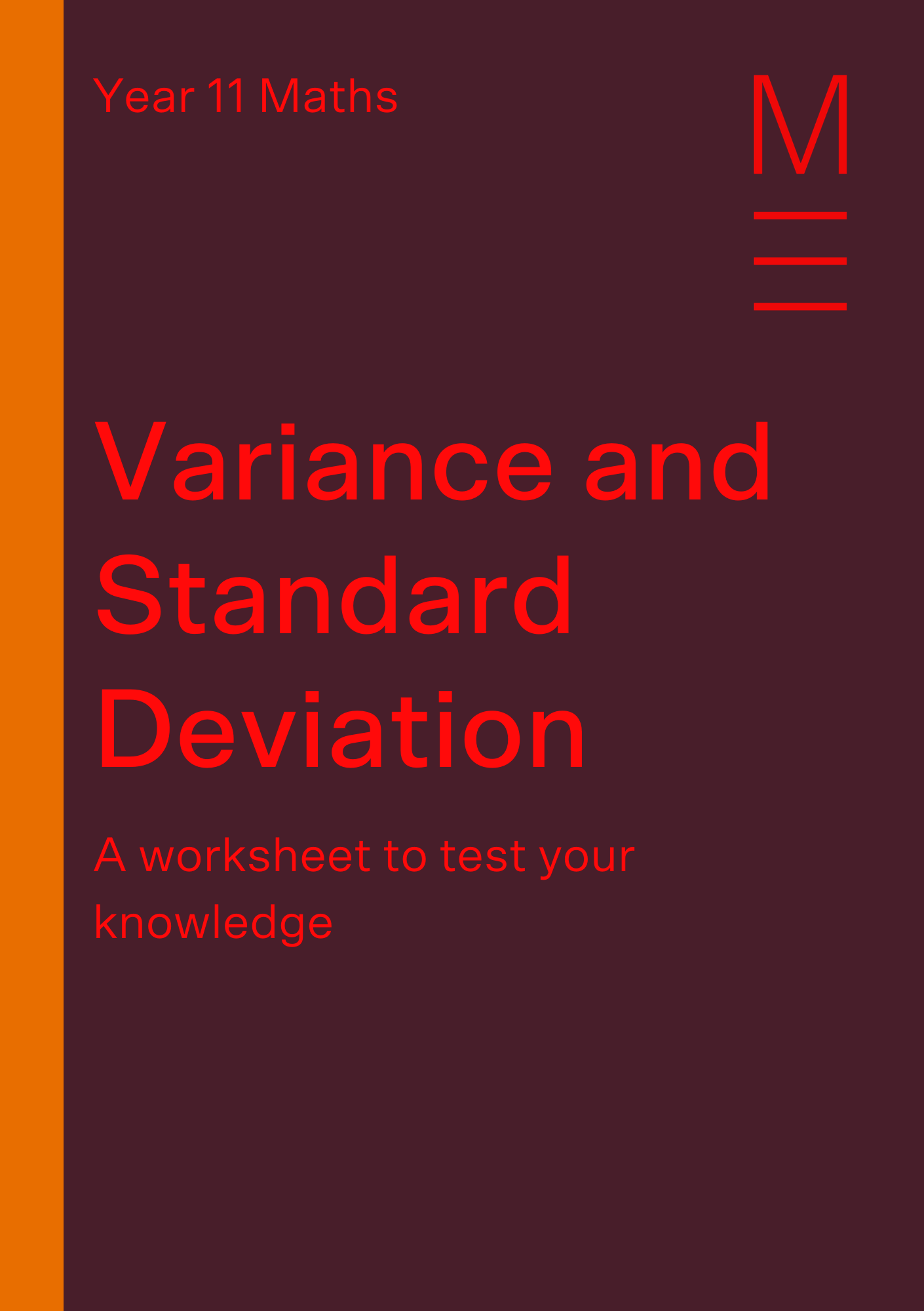Change your location
To ensure we are showing you the most relevant content, please select your location below.
Select a year to see courses
Learn online or on-campus during the term or school holidays
Learn online or on-campus during the term or school holidays
Learn online or on-campus during the term or school holidays
Learn online or on-campus during the term or school holidays
Learn online or on-campus during the term or school holidays
Learn online or on-campus during the term or school holidays
Learn online or on-campus during the term or school holidays
Get HSC Trial exam ready in just a week
Get HSC exam ready in just a week
Select a year to see available courses
Science guides to help you get ahead
Science guides to help you get ahead

Are you confused about how to calculate and manipulate the variance and standard deviation for related sets of data?
You’re not the only one! In this blog post, we’ll cover the meaning of Variance and Standard deviation to help you prepare for Year 11 Advanced Maths.
A worksheet to test your knowledge. Fill out your details below to get this resource emailed to you. "*" indicates required fields
Free Year 11 Variance and Standard Deviation Worksheet Download

Free Year 11 Variance and Standard Deviation Worksheet Download
Variance and standard deviation are measures of spread, extending upon your statistics knowledge from earlier years.
You will encounter the standard deviation again when considering probability distributions in year 12.
Additionally, a good understanding of standard deviation is key for using statistics appropriately after high school.
NESA requires students to demonstrate proficiency in the following syllabus dot points:
Students should be familiar with the definition of a discrete random variable; representations of discrete random variables; and mean and the expected value of a probability distribution.
If you need a refresher, check out our blog post on mean and expected value.
Consider these two sets of data:
\([1,2,3,4,5]\)
\([1,3,3,3,5]\)
They have the same mean \((3)\), same range \((4)\), and same median \((3)\). But they are different: the first set is more spread out, while the second one is more clustered towards the centre:
To summarise such differences, we use measures of spread, which are the range, Inter-quartile range (IQR), variance, and standard deviation.
Now, we’ve seen how the above two datasets have the same range, even though they are spread out differently.
We may similarly create two datasets with similar inter-quartile ranges but different spreads. The advantage of the variance and standard deviation is that it takes in information from all the data points, rather than just a few.
In earlier years, you may have used the following formula for variance:
\(Variance=\frac{\sum_{1}^{n}(x-\overline{x})^2}{n}\)
Let’s review the steps involved in the calculation above:
For our initial dataset, the process looks like this:
In Year \(11\) however, we will encounter discrete random variables, which don’t give us individual values for the dataset. Instead, we will encounter probability distribution tables, like the one below:
| \(X\) | \(1\) | \(2\) | \(4\) | \(5\) | \(10\) |
| \(P(X)\) | \(0.1\) | \(0.25\) | \(0.3\) | \(0.3\) | \(0.05\) |
Recall that this means that there is a \(1\) in \(10\) chance of \(x\) being \(1\), a \(1\) in \(4\) chance of \(x\) being \(2\), and so on.
Since we don’t have individual numbers, we must use a different formula for calculating the variance.
Previously, we divided by the \(n\), number of elements in our dataset to get the variance, because the chance of getting each value was \(\frac{1}{n}\).
Now that the probability is different, we need to use the expected value of the difference from the mean.
If we also notice that the mean is \(\overline{x}=μ=E(x)\) when we have a probability distribution table, then we can use the following steps:
And that’s it! The formula for variance is
\(Variance=E((x-μ)^2)\)Using the process above on the table above, we have:
Revisiting the formula:
\(Variance=E((x-μ)^2)\)We can rearrange our equation to obtain another way to calculate the variance.
\begin{align*}
E((x-μ)^2)=\sum_{1}^{n}(x-μ)^2p(x) \\
=\sum_{1}^{n}(x^2-2xμ+μ^2)p(x) \\
=\sum_{1}^{n}x^2p(x)-μ \sum_{1}^{n}xp(x)+\sum_{1}^{n}p(x)μ^2 \\
=E(x^2)-μ^2
\end{align*}
The significance of this result is that if you are given only the mean μ and the expected value of the square \(E(x^2)\), you can still calculate the variance. You can also use it to check your answers whenever a variance question pops up.
One issue with the variance as a measure of spread is that it does not scale linearly with a dataset. Consider what happens if we double our initial dataset:
\([1,2,3,4,5] -> [2,4,6,8,10]\)We might think that the spread should double, since we have doubled our dataset. But what is the variance of this dataset?
\(New Variance= \frac{(-4)^2+(-2)^2+0^2+2^2+4^2}{5}=8\)Our original variance was \(2\), so this time the variance has increased by \(4\) times. So if we double our dataset, our variance increases by \(4\) times; and if we triple our dataset, our variance will increase by \(9\) times, and so on.
This means that comparing variance in very large data sets may be difficult. How can we even out this difference?
We can try taking the square root of our variance, and this is called the standard deviation.
So, our standard deviation for our original data set is \(std.dev=\sqrt2\), and our standard deviation for our doubled data set is \(std.dev=\sqrt8=2\sqrt2\). This is double our original standard deviation, so it seems we are on the right track. Now let’s check against our second data set, when doubled:
\(New \ dataset=[2,6,6,6,10]\)
\(New \ Variance=\frac{(-4)^2+0+0+0+4^2}{5}\)
\(=\frac{32}{5}=6.4\)
\(New \ std.dev=\sqrt6.4=2\sqrt1.6\)
And our old variance was \(1.6\), which means our old standard deviation was \(\sqrt1.6\) which is half of our standard deviation for our doubled second set. The standard deviation scales the same way as our data, making it a useful statistic to measure.
In general, you can obtain the standard deviation by taking the square root of the variance, even if you are dealing with probability distributions instead of data sets:
\(Standard \ deviation=σ=\sqrt(Variance)\)
Standard deviation will appear again in year \(12\) when looking at continuous distributions, so make sure you’re comfortable with the concept!
Just like the sample mean, a sample standard deviation exists for samples of a population, if you are not given data or a probability distribution for the full population. Do note that you do not need to know the formula for the sample standard deviation for the HSC, but you should be aware that it is different from (it is an approximation of) the population standard deviation.
The sample standard deviation gets closer to the population standard deviation (and hence is more accurate) if:The sample standard deviation gets closer to the population standard deviation (and hence is more accurate) if:- Your samples are independent of any external factor / preference- Your sample size is larger.
Matrix+ online Year 11 Maths Advanced courses are the expert guided solution to your Maths problems. Learn more now!
Get ahead with Matrix+ Online
Expert teachers, detailed feedback and one-to-one help. Learn at your own pace, wherever you are.
1. What is the variance of the following probability distribution?
| \(X\) | \(5\) | \(6\) | \(7\) |
| \(P(X)\) | \(0.3\) | \(0.4\) | \(0.3\) |
2. Given the standard deviation of a dataset is \(5\), what is the variance of the dataset?
3. If the variance of a dataset is \(16\), and the expected value of the squares of the dataset is \(22\), what is the mean of the dataset?
1. The following table can be used to calculate the variance:
| \(X\) | \(5\) | \(6\) | \(7\) |
| \(P(X)\) | \(0.3\) | \(0.4\) | \(0.3\) |
| \(xP(X)\) | \(1.5\) | \(2.4\) | \(2.1\) |
| \(x^2P(X)\) | \(7.5\) | \(14.4\) | \(14.7\) |
Then \(E(x) = 1.5+2.4+2.1 = 6.0\), and \(E(x^2)=36.6\), giving us a variance of \(0.6\).
2. The variance is the square of the standard deviation, which is \(25\).
3. Since \(Variance = E(x^2) -μ^2, μ^2=E(x^2 )-Variance = 22-16 = 6\). The mean is therefore \(\sqrt6\).
© Matrix Education and www.matrix.edu.au, 2025. Unauthorised use and/or duplication of this material without express and written permission from this site’s author and/or owner is strictly prohibited. Excerpts and links may be used, provided that full and clear credit is given to Matrix Education and www.matrix.edu.au with appropriate and specific direction to the original content.